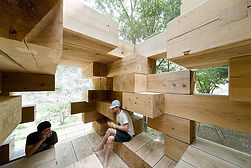
THEORIES OF ARCHITECTURE DESIGN
In architecture there is a relationship between form and function. Form refers to the shape and masses which define objects in space. It is the visual appearance of a building – line, outline, shape, composition. While function is the structural and functional requirements of a building – construction, shelter, program, organization, use, occupancy, materials. In addition, the placement of a building form in relation to its immediate site and neighboring buildings is another crucial aspect of this form and function relationship. Modernism came up with the idea that form follows function. Now postmodernism says that both function and form are important. What do you think which comes first? FORM or FUNCTION?

"Form follows function" -Louis Sullivan
Architecture today has evolved way beyond form and function. We have transcended beyond form, we create space. Relationship between a building and its users. Architecture is the result and reflection of the human activity. As in Adrian Forty's article, the acting upon people in determining the forms of buildings. Outward appearances resemble inner purposes.
Final wooden house is in a cube shaped. Its form need no justification. There are no separations of floor, wall, and ceiling here. A place that one thought was a floor becomes a chair, a ceiling, a wall from various positions. This leaves no definitive lines between each of the structure’s components, thus blending the entire interior of the space together. Here, people are distributed three-dimensionally in the space. The function of the small home is defined by how the user adapts to the wood structure. A chair could be a bed, a table- the floor you stand on. The function has no role to play in the designing of the form.
Form was used and how it enhances the aesthetics of that particular building. Architects nowadays will still shape, arrange, and connect spaces to satisfy human needs. They will still care about the qualities of visual.
CCTV Headquarters/ China
The structure of the CCTV Headquarters, and the forces at work within it, is visible on its façade: a web of diagonals that becomes dense in areas of greater stress, looser and more open in areas requiring less support. The façade itself becomes a visual manifestation of the building’s structure. The building is able to construct with new technologies. New materials are created, designs are incorporating with computer technologies to help creating this unique forms. With this unique design, the function will follow the form.
When I am to design a building, I would go for form follow function. I would use function as my guiding design principle. 'Form follows function' has always been a default ideology in architecture since then. Sometimes we can just go for 'function follows form' for your own sake. The relationship of form and function has always been important.








